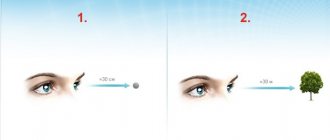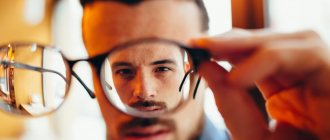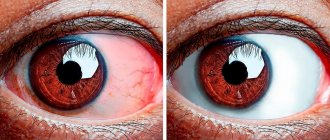Determination of myopia in children and adolescents
In children under 5–6 years of age, the examination is based on the same principle.
The child is seated on a chair, one eye is closed, and visual acuity in the other is checked. Adjust if necessary. Then they look at the second eye. Then they are asked to name what is drawn on the table (fungus, car, bear, bunny, etc.), looking with both eyes. Related article: Myopia in preschool, school-age children and adolescents
For older children, there is a table with rings in which part of the circle is missing. The subject must name in which direction the gap is directed - left, up, down or right. This is convenient for those who do not know the letters, but can guess or remember the location of the pictures in the table described above.
How to determine vision using a table
Diagnosing myopia using a table helps to quickly and easily identify the presence of pathology. Determination of visual acuity is possible in both adults and children. Knowing how the eye sees, the doctor can prescribe treatment and prescribe glasses. This significantly makes the patient’s life easier and improves its quality.
Video: How to check visual acuity (Sivtsev table)
In addition to diagnosing the problem, using the table it is convenient to track the dynamics of the condition. For example, is there any improvement after the course of therapy or is there a worsening or progression of myopia. In such cases, the question of performing surgery to correct myopia may be raised.
What is myopia
In medical terminology, myopia means myopia. This disease is characterized by a peculiarity of the optical structure of the retina. The focus of the image does not completely fall within the coverage area of the retina, but appears to be slightly in front of it.
This means that the optics of the eyeball will refract light to a slightly greater extent than is normally required. The light will be focused before passing into the retina, which is responsible for processing and receiving the image.
This means that myopia or myopia is a pathologically abnormal structure of the optical system of the eye. Characterized by the focus of the image falling in front of the retina, and not directly on it.
Myopia - causes and treatment. How to restore vision:
I can’t see far—is it myopia or farsightedness?
Sometimes a person notices that he has some strangeness with his vision and perception of the world around him, but at the same time, he is not yet ready to admit that he has this or that disease.
If an image that is as close as possible to a person’s eyes is perceived clearly, with correct color rendition and sharp contours, then it means that he does not have farsightedness.
However, if objects that are far away for a person are fuzzy, blurry, and sometimes he cannot at all understand what he sees in front of him in the distance, then in this case he suffers from myopia or myopia.
Myopia is characterized by a minus index. But why is this happening? When a person purchases glasses or contact lenses that are intended for nearsighted people, he sets specific goals for them. Namely, scatter the light rays and try to move the focus of the image as close to the retina as possible. Or better yet, right at her. As a result of such manipulations, a person begins to see clearly, and most importantly, with the necessary clarity and sharpness.
Concave lenses and glasses are not just an object and an accessory. These are diopters, which are indicated by a minus sign. That is why myopia is popularly called “minus”.
Features of visual processes in people with myopia
People suffering from myopia have visual impairments that often prevent them from living their lives to the fullest. Distant objects that are further than 50 cm, that is, half a meter, are not seen clearly by them. And the further away an object is located, the more blurry its contours, dull colors and fuzzy structure it has. Sometimes this is very life-threatening if the person does not wear glasses or contact lenses.
However, as you approach this object, it will gradually begin to acquire a clear outline.
Therefore, it is very easy to identify a myopic person in the general mass of people. Sitting without glasses or even wearing them, he will, by inertia, keep the source of information as close to his eyes as possible, for example, a gadget, book, paper, and so on. This is necessary in order to see the necessary information as clearly as possible, and therefore as closely as possible.
If a person has myopia of 20 diopters, he will wear very thick glasses or lenses, which will greatly reduce the size of his eyes for the people around him.
There is also the concept of false myopia, which is also often found in medical practice.
Expert opinion Kim Oksana Aleksandrovna Head of the ophthalmology clinic. Ophthalmologist with more than 10 years of experience.
False myopia caused by spasm, that is, simple muscle strain. These spasms control the lens of the eye. A person who tries to peer into the distance unconsciously relaxes his muscles, and the lens, which has a flat shape, stops focusing on the retina. The same thing happens, but to a greater extent when we overexert ourselves. The lens cannot concentrate on the image, so it becomes blurry and out of focus.
Constant muscle tension provokes false myopia. Treatment is carried out in the same way as for patients with myopia. A person is prescribed glasses or contact lenses that will allow him not to strain his vision when looking into the distance. Over time, the person will lower the diopter value so that the eye will independently recover to 100 percent.
Symptoms of farsightedness
The main symptom is poor near vision. At the same time, the patient sees objects located in the distance well. However, over time, the pathology may intensify due to the loss of the accommodative properties of the lens.
The main symptoms, the presence of which prompts you to consult an ophthalmologist with suspected hypermetropia, include:
- Impaired near vision.
- Disturbance of “distant” vision.
- Increased eye fatigue when working.
- Visual fatigue when reading books.
- Frequent conjunctivitis and other inflammatory processes of the eyes.
- Strabismus in childhood.
Treatment
Qualified treatment of myopia, including those with visual acuity readings of -2, is carried out according to a general scheme that works in three directions. It provides:
- stopping the pathological growth of the eye (if such a symptom exists) by scleroplasty;
- prevention of complications;
- restoration of refraction through surgical correction, the use of special optics or orthokeratology - a technique based on the use of a separate type of lenses - night lenses.
Also, treatment of myopia in the early stages involves regularly performing eye exercises. It is aimed at improving metabolic processes in the tissues of the eye, increasing visual acuity and relieving tension. Often this particular set of exercises is aimed at stopping the progression of the disease. In addition to it, for therapeutic purposes, the patient is also often prescribed to take local medications: eye drops, vitamins. They also accompany methods of laser or surgical correction when it comes to the speedy restoration of eye tissue.
In the vast majority of cases, correctly selected treatment for myopia helps to overcome the disease completely. However, if it was not carried out properly, there is a high risk of complications: the appearance of ailments that are much more severe than myopia.
Information about eye microsurgery can be found in this article.
Complications
Several severe complications of myopia are known in medical practice. Among them:
- Glaucoma.
- Retinal detachment.
- Cataract.
- Macular degeneration.
All of the above diseases, to one degree or another, carry the risk of irreversible vision loss. That is why a patient who has been diagnosed with myopia at any stage needs to do everything to avoid them. In addition to the main treatment, preventive methods will also help him in this matter.
You can read about the symptoms of glaucoma by following this link.
Prevention
Myopia, like other vision problems, cannot be excluded with 100% probability in each specific case. However, you can significantly reduce the risks of their occurrence, as well as slow down the development of pathology if you have already detected it. Simple preventive measures can help in this matter. These include:
- gymnastics for the eyes;
- compliance with visual hygiene standards;
- correction of the diet by adding the maximum amount of foods for vision, containing the necessary vitamins and minerals (fish, blueberries, carrots, beans, etc.);
- regular examination by an ophthalmologist at least once every six months;
- taking preventive medications against myopia: drops and vitamin complexes;
- moderate physical activity: gymnastics, swimming, fitness.
In some cases, these preventive measures can not only prevent myopia or stop its progress, but also significantly improve vision. However, the patient can count on such an effect only if he follows the instructions regularly and scrupulously. Otherwise they will be ineffective.
Contact correction
I can't see well up close. What to do? Another popular method of vision correction is contact lenses. Today, for presbyopia, several methods can be proposed:
- Contact multifocal lenses. By the way, they are quite common lately. They have a peripheral and central zone, which is responsible for clarity of vision. That is, it becomes possible to increase the field of view without unnecessary deformation. For the manufacture of multifocal lenses, a special innovative material is used that allows the eyes to “breathe”. With such lenses, a person can see equally well both near and far.
- "Monovision". This type of contact lenses is selected for patients who have both farsightedness and nearsightedness. One eye here will be corrected to clearly distinguish objects in the distance, and the other - for visual acuity in the distance. Therefore, the patient does not need to buy different glasses. But the disadvantage of “monovision” is that it sometimes requires a long period of getting used to. In addition, as the name implies, a person loses the ability to have binocular vision.
Choosing eyepieces: some subtleties
The degree of visual deviation from the norm is determined by a specialist. He writes out the prescription, but everything else (lens material and frame type) is chosen by the patient according to his preferences. Constant wearing of glasses is necessary only for degrees 2 and 3 myopia. Competent correction can improve the patient’s vision and prevent its deterioration.
Lenses
There are two types of lenses:
- Made of mineral glass - they are highly resistant and perfectly transparent, they have stronger optical properties, protect the eyes from UV rays, but they are heavy and thick. The downside is that they fight and create a danger. Such glasses, for example, are not recommended for professional athletes.
- Plastic ones are the most modern. The advantage of such lenses is lightness and strength. Disadvantages - short service life due to rapid rubbing with small scratches, insufficient optical power - less diopters. Therefore, compensation of the visual defect is not always possible to the full extent.
The surface can be: colorless transparent, painted in a certain color and photochromic (chameleons).
The coating can be anti-reflective. Such glasses filter out light streams, leaving only the safe spectrum - yellow). For computer work, there are glasses with a protective coating to quickly defog the lenses.
The surface shape of the lenses for myopia is diverging, and they are thicker at the edges. There are 3 types: flat, convex, and biconcave lenses. The thickness at the edges directly depends on the degree of myopia.
Frame selection
The following types of frames exist:
- metal;
- plastic;
- without frame.
The stage of myopia also determines the type.
The advantages of plastic frames are their lightness, they do not put pressure on the bridge of the nose, do not react to external temperature, are comfortable, but short-lived.
Metal frames are more reliable, suitable for thick glasses, but they are heavy and oxidize over time.
The “2 in 1” option is a metal frame around the glass with plastic temples. Lenses for small visual deviations are quite thin. They need a metal frame. At the same time, the metal does not bear a large load on the bridge of the nose.
The absence of a frame will be justified in cases of second degree myopia; here thicker lenses are needed and the metal will make the structure heavier.
For grade 3 myopia, it is advisable to purchase plastic frames.
Memo to the patient: sequence of actions when choosing glasses
First, the patient should visit an ophthalmologist.
To select glasses, the doctor must:
- identify the cause of myopia;
- set the level and degree of myopia for each eye;
- determine the level of correction in diopters;
- identify concomitant diseases and astigmatism;
- measure the center value of the glass and select a frame;
- determine the complexity of the lens.
Important! Glasses for myopia are worn not only for visual acuity, but also to prevent complications.
How to purchase glasses:
- For high myopia, it is desirable to have a wide frame so that heavy lenses are securely fixed in it and their thick edge is closed.
- For low diopters, the frame is better without a rim or half of it.
Diagnostics
So, if you have something to worry about, you have discovered some symptoms, you need to carry out a diagnostic procedure. You need to do it both independently and in the doctor’s office.
What is the focus of the audit?
- The doctor checks visual acuity.
- Determines the degree of myopia.
- The length of the eyeball will be measured.
- The fundus of the eye is examined for the presence of dystrophy.
- The thickness of the cornea is measured.
How to check your visual acuity yourself?
At home, you can only check visual acuity, using special auxiliary tables. Visual acuity refers to the ability of the eyeball to distinguish between two points that are located at a minimum distance from each other. This is an indicator of visual acuity.
Most often, the indicator “one” is taken as the norm. That is, we can say that a person who does not suffer from myopia has one hundred percent vision.
At the same time, a person may have visual acuity that is much greater than normal, for example, an indicator of one and a half.
However, many people have visual acuity between 0.8 and 0.5. And this is also considered a healthy number.
Farsightedness and astigmatism
Astigmatism
– visual impairment caused by an irregular shape of the cornea, lens, eyeball, or a combination of these defects. Along with myopia and farsightedness, astigmatism refers to ametropia - pathological changes in the refractive function of the optical media of the eye with distortion of the rear focus. In the structure of ophthalmological diseases, astigmatism accounts for up to 10% of the total number of diagnoses.
Due to the uneven curvature of the cornea and/or lens, light rays entering the eye do not converge at one point, as they should, but take the form of a segment, ellipse or figure eight, and they can be focused both on and behind the retina, and in front of her. A person suffering from astigmatism sees surrounding objects as distorted, blurry, or even double.
The most common cause of the development of the disease is a hereditary factor - if one of the parents has astigmatism, in 50% of cases the same diagnosis will be made to their child at an early age. However, there is also an acquired form of the disease caused by cicatricial changes, injuries and eye tumors, ophthalmological operations, inflammatory and degenerative processes.
Classification of astigmatism:
- By localization
distinguish corneal and lens astigmatism;
- By refraction
There are three types of main meridians (perpendicular planes of the eyes) - direct (the refractive power of the vertical meridian predominates), reverse (horizontal) and astigmatism with oblique axes;
- By appearance
They distinguish regular astigmatism, in which the meridians are perpendicular to each other, and irregular, when this is not the case. In turn, correct astigmatism is divided into simple (in one of the meridians the refraction is normal), complex (with myopia or hypermetropia in both meridians) and mixed (with different refraction in the meridians);
- By origin
there are congenital and acquired forms of the disease, and congenital astigmatism up to 0.75 diopters is physiological and does not need correction, while acquired astigmatism is always pathological;
- By degree
There are mild (up to 3 diopters), moderate (3-6 diopters) and severe astigmatism (more than 6 diopters). It depends on what the difference in degrees is between the degree of refraction of the strongest and weakest meridians.
So, there is a mixed type of disease, in which the refraction in the meridians is different, then we can say that a person has myopia and farsightedness at the same time, and this visual impairment is aggravated by distortions caused by astigmatism.
Microsurgery and laser correction are used to treat the disease. Correcting severe astigmatism with glasses is very difficult. If, with astigmatism over 1 diopter, there is a progressive decrease in visual acuity, asthenopia, increased farsightedness or myopia, you must urgently seek help from an ophthalmologist.
What level of vision requires glasses?
The ophthalmologist decides for which vision the patient needs to wear glasses individually. This is influenced by factors such as age and the disease itself.
Visual acuity is measured in diopters. This is the refractive power of the light flux.
For myopia
Thanks to special studies, it was revealed that glasses for myopia (myopia) must be worn when working or watching TV with visual acuity from -0.75 diopters to -3 diopters. If the patient's vision is -3 or more, optics are prescribed for constant wear.
In addition, myopia is divided into two types: accommodative and anatomical. With anatomical form, wearing glasses is necessary. This is due to the fact that such pathology tends to progress. Vision correction optics can prevent this. With the accommodative variety, the task of the treating specialist is to strengthen the muscles of the visual apparatus. In this case, wearing glasses can be harmful, since the muscles relax in this case. The best solution would be to perform special gymnastics for the eyes.
For farsightedness
Glasses for farsightedness (hyperopia) are prescribed at values of +0.75 diopters. They can be prescribed for both temporary and permanent wear. If the patient does not have concomitant eye diseases (astigmatism, myopia, etc.) and objects lose their contour only at close range, the patient is prescribed optics for temporary use. They are worn when reading, writing, working on a computer, watching TV, driving, and doing minor work.
The decision to make adjustments using glasses is made by the doctor individually for each patient. Even with poor vision, if this does not bother you in any way, corrective optics may not be prescribed.
Symptoms
A person has trouble seeing close up. This is farsightedness, which can be determined by accompanying symptoms:
- When there is stress on the organs of vision (for example, when reading, working at a computer), a person may notice discomfort and pain in the eyes.
- "Lazy eye syndrome." When visual acuity decreases, the eye that sees worse ceases to fully perform its functions.
- The closer objects are to a person, the more blurred their outlines are.
- After prolonged strain on the organs of vision, an unpleasant itching or burning sensation may appear in the eye.
The more complex the ophthalmological problem, the more clearly these symptoms manifest themselves. In especially severe cases, a person without glasses or contact lenses is no longer able to see his surroundings even at arm's length.
How to choose the right glasses at different stages of myopia
Myopia has 3 stages:
- Weak degrees - from -0.25 to -3.0 D.
- Average degree – from -3.25 to -6.0 D.
- High degree - from -6.25 D and above.
To choose the right glasses to correct myopia, the optometrist adheres to the following principles.
Selection rules:
- Determine the amount of myopia for each eye in a state of immobility and movement.
- Carry out correction taking into account binocular vision.
- If myopia is up to -6.0 D, it is necessary to restore near vision as much as possible.
- High myopia is fully corrected.
- With a high degree of myopia, the ophthalmologist may recommend 2 pairs: for close distance and for distance.
During the selection of correction means, diverging lenses are installed in front of the patient. If at the same time visual acuity increases, this indicates that he has myopia. The doctor begins the selection with weak lenses, moving to stronger values if the patient’s vision improves.
The procedure is carried out until the person achieves the highest visual acuity. If during selection there are 2 lenses left with which the patient can see as clearly as possible, the choice is made on the weaker one. Glasses are purchased depending on the degree of myopia:
- For high myopia, it is advisable to choose a wide frame so that heavy lenses are securely fixed in it and their thick edge is closed.
- For low diopter values, it is recommended to purchase semi-rimless or rimless frames.
- For myopia, lenses are made of glass or modern plastic, and for high diopters it is advisable to thin the material so that the glasses do not visually make the eyes smaller.
Main causes of farsightedness
So, as already stated, farsightedness is an eye disease in which the image is focused behind the retina. The degree of development of hypermetropia depends on the eye’s ability to refract light rays and on accommodation (the ability of the lens to change its shape depending on the distance to the object):
- Weak (up to +2 diopters).
- Medium (from +2 to +5 diopters).
- Strong (more than +5 diopters).
There are two causes of farsightedness:
- The eyeball is too short, and therefore the longitudinal ocular axis is short. Most often, this visual disorder is hereditary.
- Insufficient refractive properties of the visual system. With age, the human lens loses elasticity and corresponding abilities.
There is also the possibility of a combination of these two reasons.
Is myopia a plus or a minus?
Myopia is a vision defect in which the image is formed in front of the retina rather than on it. Over the past decades, the number of people with this disease has increased significantly.
Myopia develops mainly in young people, schoolchildren and students. Often, when the first signs of this condition appear, many people have a question: “is myopia a plus or a minus.”
Causes of the disease
Myopia most often develops during school years. Moreover, heredity plays a significant role here. Among the factors contributing to the development of this disease are prolonged work at close distances under poor hygienic conditions or improper lighting. Given the massive distribution of computers, this problem is becoming serious.
If measures are not taken to eliminate myopia in a timely manner, this condition can lead to irreversible changes and significant loss of visual function. This in turn will partially or completely limit your ability to work.
Weakening of the eye muscles also contributes to the development of myopia. To solve this problem, special sets of physical exercises have been developed that can be used for both therapeutic and preventive purposes.
As a result, the progression of this disease is often slowed down or stopped. Previously, it was recommended to limit physical activity for people suffering from myopia. However, moderate exercise with a rational rest and sleep regime is currently recommended.
At a young age, myopia can be caused by a spasm of accommodation, changes in the shape of the cornea (keratoconus), displacement due to lens injuries (luxation, subluxation), and sclerosis of the lens. The latter pathological condition leads to the development of myopia in old age.
Correcting high myopia is difficult and requires an individual approach to the selection of lenses for distance and near. With the development of senile myopia due to sclerosis of the lens, it is replaced or implanted with phakic lenses.
Methods of treatment and correction
Based on the above facts, we can conclude that this disease is a disadvantage and therefore requires immediate treatment. This is especially true for medium (3.26-6 diopters) and high (over six diopters) degrees of the disease.
Weak (up to three diopters) and sometimes moderate forms of myopia are eliminated with the help of optical correction for distance using weak (one or two diopters) lenses for working at close distances.
Minus (negative) lenses are used to correct myopia. In this case, negative lenses are placed in front of the patient’s eye, then they look at the result. They start with weak lenses; if vision does not improve, then use stronger glasses. As a result, maximum vision restoration is achieved using a specific minus lens.
Depending on the degree of myopia, a person may experience a temporary or permanent need for glasses. A modern method of treating this disease is laser correction. However, it allows you to compensate for myopia.
Preventive measures
In order to avoid myopia, it is necessary to take preventive measures. These include proper lighting when reading and working at the computer, performing special exercises for the eyes, correct posture, etc.
Vitamin therapy will help strengthen not only the immune system, but also increase the sensitivity of the visual apparatus to stress. Physiotherapeutic procedures stimulate blood circulation in the eye tissue. For these purposes, special medications can be used.
Thus, to the question: “is myopia a plus or a minus,” we can give a clear answer: “minus,” since this disease is prone to constant progression and can lead to complete loss of vision. That is why its prevention and adequate correction are extremely important.
Doctors' advice
If the patient has a tendency to develop myopia, or has already developed it, the following rules must be followed:
- eating food containing all the beneficial substances, trace elements, minerals necessary for the normal functioning of the eyeballs and other organs;
- in autumn-winter it is recommended to take multivitamins that promote the intake of substances in the body, the amount of which is reduced;
- daily eye gymnastics, which reduces the risk of developing a spasm of accommodation;
- taking breaks during long work to maintain the functionality of the eyeballs;
- an annual visit to an ophthalmologist to promptly identify various abnormalities, especially for people with chronic eye disease.
We recommend reading: Prevention of myopia
Myopia is a condition of the eyeballs in which distance visual acuity is reduced. It is necessary to promptly identify the disease and apply treatment. Treatment methods include the use of glasses, contact lenses, and laser surgery.
Can you be nearsighted and farsighted at the same time?
It’s hard to believe, but in some cases, both pathologies develop in the affected eye at once. The reason for this may be a more complex form of eye disease. More about her later.
What is the name of the disease, its symptoms and complications
When we talk about simultaneous myopia and farsightedness, we mean one of the following serious vision pathologies.
Presbyopia is a disease characterized by the presence of both hypermetropia and myopia, with the latter often occurring against the background of the former.
The pathology is popularly known as “senile disease” because it develops due to age-related changes in the body. The disease is typical for people over 45 years of age.
The manifestation occurs against the background of decreased elasticity of the lens and its inability to accommodate. If presbyopia develops against the background of weak myopia, the latter will practically not harm the patient in any way, but when it comes to a high degree of myopia, then they talk about a complication, because the ability to see sharply deteriorates, so the doctor prescribes two glasses or complex lenses at once.
Main symptoms of presbyopia:
- Rapid eye fatigue when reading;
- Poor picture contrast;
- Need for bright lighting;
- Indiscernibility of small details at close range.
Astigmatism is another case where two pathologies are observed simultaneously. The disease is more common in young people and even small children, since it can be congenital.
The disease manifests itself against the background of gradual deformation of the cornea, as a result of which light refraction occurs in several meridians at once.
It is important to note that astigmatism has several types: myopic, hyperopic, mixed. The latter presupposes the presence of both myopia and farsightedness
More often, each of the pathologies is located in a separate eye, but if complications occur, both defects are present in both eyes.
The presence of mixed astigmatism is indicated by the following signs:
- Frequent darkening of the eyes, double vision;
- blurred vision;
- Fuzzy vision of objects located both far and near;
- Sensitivity to light, appearance of blackheads;
- Rapid eye fatigue.
Diagnostics and treatment: correction with glasses, lenses, laser, surgery
To correctly recognize presbyopia, the specialist takes into account the obtained diagnostic data and the patient’s complaints, as well as age characteristics.
Initially, the doctor checks visual acuity, then performs lensmetry (determines the refractive power of glasses) using a special device - a lensmeter.
It also examines the patient’s closest point of clear vision, after which he conducts computer diagnostics of the eyes.
For a high-quality diagnosis of mixed astigmatism, the ophthalmologist needs to conduct visometry using a special table, conduct computer diagnostics of the patient’s eyes, determine the curvature of the cornea and examine the fundus.
The treatment for both types of the disease is similar, so let’s analyze it in a single key:
- Vision correction with glasses and contact lenses. For astigmatism, complex glasses are prescribed, consisting of two lenses: one of them reduces the refraction of light, the other increases it. Children are prescribed to wear on an ongoing basis. Adults are prescribed primarily for reading or watching video information. Contact lenses are considered a more convenient and effective way to temporarily correct the disease. Unfortunately, such correction methods are unable to restore the organ of vision.
- Laser correction. This correction method allows you to achieve correct focusing of the image on the retina (in the case of presbyopia) or simulate the desired curvature of the cornea.
- Surgery. In the case of astigmatism, astigmatic keratotomy (microincisions that correct the curvature of the cornea) is used. For presbyopia, the worn out lens of the eye is replaced.
Diagnosis and treatment of farsightedness
Contacting an ophthalmologist is necessary at the first signs of decreased visual acuity. Diagnostics will proceed approximately in the following sequence:
- The level of vision changes is studied using Orlova, Golovin or Sivtsev tables.
- The fundus of the eye is checked using a special mirror or ultrasound.
Diagnosis and treatment of farsightedness
To avoid vision problems, you need to:
- choose the right lighting;
- using special gymnastics according to the Bates method, train the eye muscles;
- correct vision correction;
- exercise and eat well.
Basic medical methods for treating farsightedness:
- Wearing glasses and contacts.
- Correction with a laser beam (for patients over 18 years old).
- Lens implantation through surgery.
Practice shows that most people become farsighted between forty and fifty years of age: the lens becomes denser and causes blurred vision. But the development of the disease can be stopped by correcting the course of the abnormal process.
This is how people with farsightedness see
Age-related farsightedness was previously considered an incurable disease and could only be corrected by wearing “plus” glasses. Later they began to perform surgical operations to implant a special lens, with the help of which near and far vision is restored. A multifocal lens is implanted in place of the removed lens through a very small incision. Within about fifteen minutes after the operation, the ability of the eyes to distinguish nearby objects is noticeably restored.
Using microsurgery methods that were not previously available, vision can be completely restored.
Today, the most common methods of treatment for farsightedness are:
| Method | Description |
| Radial keratotomy | A breakthrough in this area of medicine came with the advent of the method of incisions on the cornea. It changed when microscopic incisions were tightened and overgrown, as a result of which the optical capabilities of the cornea increased. Now this treatment method has been recognized as risky and unpredictable due to long healing times and the impossibility of restoring both eyes at once. |
| Keratoplasty | A method of reshaping the cornea using donor tissue placed inside the cornea on the front layer or replacing it completely |
| Lensectomy | It is essentially a refractive lens replacement that helps cure hyperopia of the highest degree. Previously, such a pathology was considered hopeless. The method involves replacing the lens with an artificial one. The method is good for treating older patients. The operation lasts about half an hour, there is no need for stitches or hospital stay |
| Implantation of phakic lenses | Applicable for moderate disturbance of natural accommodation. During the operation, the native lens remains in place, and a special lens is additionally inserted |
| Laser correction method | The laser correction method has become the most popular, tested and reliable method. The convenience of this method is that the operation is carried out within one day. The laser beam corrects the shape of the cornea without penetrating into the deep tissues of the eye |
Farsightedness, which progresses rapidly, is corrected by implantation of an artificial lens or an additional actual lens. These procedures are considered safe for health since the risk is minimal. But many patients believe that one percent risk is a serious argument against laser correction, and continue to use glasses or corrective lenses.
Non-traditional treatment of farsightedness
Traditional medicine recipes for stimulating the visual apparatus recommend treatment with an infusion of marsh calamus herb. Schisandra herb should also help solve this problem.
An unconventional method for correcting vision problems was developed by Dr. Norbekov. It includes simple sets of exercises for the eyes, joint gymnastics, control of your own posture and positive emotions.
Treatment
Vision can be corrected in various ways. You need to undergo a full examination and contact experienced ophthalmologists. There are different methods of treatment, as well as mechanical enhancement of visual acuity.
Let's look at the main options:
- The most common adjustment is applied. For this, people use glasses and contact lenses. In this case, vision becomes sharper instantly. If you do not wear glasses all the time, their use will even become useful, since it will relieve increased tension from the eyes. People still argue about wearing lenses, because some consider lenses harmful and not hygienic enough. But in fact, if you completely follow the instructions, do not overwear the lenses, and choose only high-quality products from trusted manufacturers, there will be no harm from them.
- There are special operations during which special lenses are placed directly inside the eye. In this way, a prolonged effect is achieved.
- It is also possible to completely renew the lens. Surgical interventions to insert an artificial lens have been known for a very long time and are still quite actively practiced. The old real lens is removed, and an artificial one made of modern material is installed in its place.
- Many people prefer laser correction, in which pathology is eliminated with laser beams. This operation is performed quickly, requires virtually no time for subsequent recovery, and has almost no contraindications.
- Another technique involves wearing special corrective lenses at night. This is the so-called refractive method. Before going to bed, the patient inserts special lenses that change the shape of the eye and make it flatter. As a result, then, after removing the lenses during the day, the eyeball retains its correct shape, and visual acuity increases as a result. The method is interesting, but it has its opponents.
With progressive myopia, surgical intervention becomes necessary, since delay can even lead to complete loss of vision and disability.
be careful
Try to pay attention to alarming symptoms, check your visual acuity more often and be sure to regularly visit an ophthalmologist
Age characteristics
Plus vision (farsightedness) is physiological for a newborn. Due to the small size of the eyeball and the great elasticity of the lens capsule, the child’s near vision is blurred in the first months, visual acuity is about plus three or even more. As the organs of vision develop, their ability to focus also changes, and visual acuity becomes normal in adults.
If, upon examination by a pediatric ophthalmologist, the prerequisites for maintaining positive vision are determined, then farsightedness correction is performed with glasses. Glasses for children with farsightedness are designed to be worn constantly. Their optical power is selected one unit less than the power of hypermetropia. This technique is justified for children's eyes as it stimulates their growth and helps reduce farsightedness.
Since the structures of the lens and ciliary muscles in children are very elastic and are able to compensate for a refractive error, a vision test is carried out by first instilling Pilocarpine eye drops. This medicine “turns off” the accommodative apparatus of the eye and allows you to identify true or false farsightedness.
Treatment of childhood farsightedness, in addition to correction with glasses, is also carried out using physiotherapeutic methods that stimulate the development of the visual organs. Courses of therapy are carried out every quarter until the eye is fully formed.
Also, due to genetic predisposition or other factors, a child may develop a refractive error, when one eye has a plus index, the other – minus. This condition requires mandatory correction immediately upon detection, since over time, signals from the weaker eye begin to be ignored by the brain, since they are not informative. Gradually, the eye loses its function and amblyopia develops - a decrease in vision that cannot be corrected.
Also, the optical power of the eye can “change sign” with age. In the second half of life, those who suffer from nearsightedness may notice improved distance vision, but blurred foreground.
Most people after 40–50 years develop so-called senile farsightedness – presbyopia.
The muscles responsible for contracting the lens weaken, and it almost always remains in its flatter form. The so-called “long arm” state develops - a person, in order to see small details or text, moves them further away from himself.
Prevention
Compliance with preventive measures will reduce the likelihood of vision deterioration and will always allow you to see well both at a distance and at close distances:
- sufficient amount of vitamins in the diet;
- rejection of bad habits;
- good sleep;
- a break during visual work and performing eye exercises;
- work only in sufficient lighting;
- refusal to read while moving traffic;
- annual examination by an ophthalmologist.
If you notice that your distance vision has become difficult, do not put off visiting a doctor. The sooner you receive treatment, the better your quality of life will be.
In addition, you can see the top 5 eye massage methods to improve vision:
How good or bad is your distance vision? Share your feelings in the comments. Repost so that your loved ones know about the problem. Be healthy.
Hereditary predisposition
Not all schoolchildren who do homework and play on the computer wear glasses. Doctors unanimously say that heredity is to blame. Even by examining the eyes of a newborn, you can understand whether he is at risk of myopia in the future.
- Children of parents with myopia are at risk. If both father and mother have abnormalities, the likelihood of an appropriate diagnosis being made in the child is maximum - weak connective tissue is inherited;
- Premature babies are the first in line to wear glasses. Being born prematurely prevents the visual system from developing normally. In case of premature birth, the child may have no lateral vision;
- Pneumonia, flu, frequent colds and allergies also increase the risk of developing myopia. The reason is impaired metabolism in the organs of vision, stretching of the sclera.











